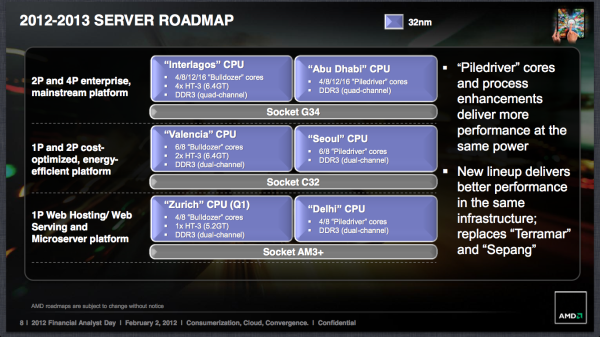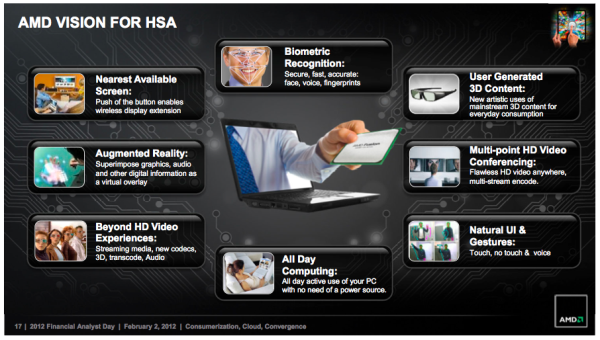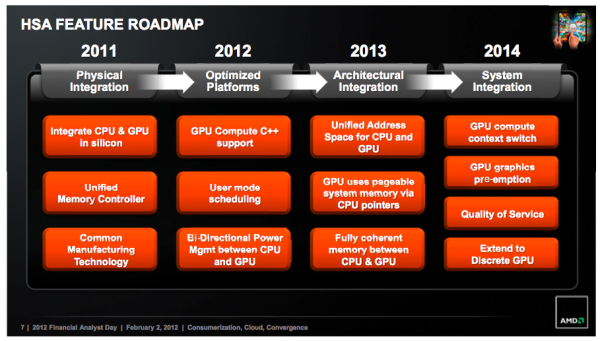Understanding AMD's Roadmap & New Direction
by Anand Lal Shimpi on February 2, 2012 6:16 PM EST- Posted in
- CPUs
- AMD
- Trade Shows
- AMD FAD 2012
The New Focus: Client Mobility
For years we had asked for lower power AMD mobile solutions. While we finally started seeing some progress over the past couple of years, AMD is now very committed to building mobile devices. Anything tablet sized or above is now AMD's target for client APUs.
AMD was always the high-end x86 CPU alternative to Intel in the PC space, now AMD is going to be the alternative in the ultra mobile space.
Servers & the High End Desktop
AMD's server roadmap for the next two years is a bit more conservative. We'll see Piledriver updates from top to bottom but there's no significant departure from the way things are done today. There are no plans for any new sockets in the near term, just using existing platforms to grow AMD's server marketshare without huge new investments.
As AMD's client strategy is predominantly built around APUs, the only high-end desktop parts we'll see from AMD are low-end server CPUs. Socket-AM3+ has a future for one more generation and we'll likely see other single-socket, high-end platforms for the desktop. The days of AMD chasing Intel for the high-end desktop market are done though. That war is officially over.
The Ace: HSA
AMD isn't going to have the fastest general purpose x86 CPUs on the market and it is no longer interested in pursuing that goal. It does promise to have much better on-die GPU performance than Intel. For users today that's primarily an advantage in 3D gaming. As more workloads shift to the GPU however, AMD could have a significant advantage here. The problem is that seamlessly scheduling client workloads across CPUs and GPUs just hasn't happened, the two islands of compute horsepower have remained discrete - even on the new wave of integrated APUs.
AMD's Heterogenous Systems Architecture (HSA) plans to change that. AMD wants to see the creation of a virtual ISA that will be the backbone of a software layer that can schedule application workloads on any combination of underlying CPU/GPU hardware, regardless of the ISA of the hardware. If you have a workload that's best run on big, general purpose x86 cores, that's where it will run. If a task is better designed for highly parallel GPUs cores, it'll run there. And presumably if you had an ARM core somewhere underneath and the workload would run better on it, you'd be covered as well.
AMD plans on delivering an HSA enabled GPU family by 2014, with today's Graphics Core Next GPUs being an intermediary step that already fill a number of these goals. These HSA GPUs would be able to share the same memory space as CPUs and work seamlessly as coprocessors. Granted AMD doesn't have the best track record of quickly moving the industry with things like HSA (although AMD64 did work out quite well), so we'll have to wait and see how all of this plays out.
If AMD can get broad industry support for HSA then its APUs become much more attractive. The overall performance of AMD solutions would then become more compelling as they'd take both CPU and GPU architectures into account, again assuming the workloads require both.













84 Comments
View All Comments
spidey81 - Thursday, February 2, 2012 - link
There's nothing about what I asked that suggested AMD pander to the so called "high end". But they have been going for the mainstream enthusiast market with their unlocked CPU's. I don't have an unlimited budget and the most I've spent on a CPU or GPU is $300. I'm just hoping I'll see some better competition in the "value" enthusiast segment.Sabresiberian - Friday, February 3, 2012 - link
I certainly would have agreed at the time I built my systems that the cost/performance value favored AMD's Phenom II. I even recommended tit over the 1366 based platform to people building new computers, because they could not afford spending the extra money.However, I was an early adopter of Nehalem, and paid a premium for what I got. Today isn't yesterday, we have an extensive Sandy Bridge lineup to choose from, and AMD's offerings don't hold up.
As an example, I direct you to this article:
http://www.tomshardware.com/reviews/gaming-fx-pent...
The article is gaming oriented, and many Anandtech.com readers don't fit in that category, but even so I think it is of interest to those building or buying a new computer for any purpose. The fact is, AMD isn't just "losing" the performance "war", it is losing the cost effectiveness war as well. (I don't want downplay the fact that gaming benchmarks can have little to do with other needs, but if you really check prices and benchmarks for more business-oriented applications I think you'll find I'm not far off the mark there, too, for desktop CPUs.)
I suggest that far more than 5% of users would benefit from using an Intel offering over an AMD at any price point.
;)
wumpus - Wednesday, June 27, 2012 - link
First, the last Intel CPU I've used was a P3 base Celery. Looks I'll be going to Intel sooner or later.Two exceptions:
First, those of us with AM3+ sockets will have to decide if a new motherboard is worth it. This changes the value calculations enough for the 5%.
Second, I suspect Anandtech readers get roped into "supporting" more computers than they use outright. Even on the desktop, llanos-type CPUs will become more and more appropriate for any purchase not based on geek lust.
riottime - Thursday, February 2, 2012 - link
i'll wait until steamroller to upgrade my amd build. i plan to get ivy to upgrade my intel build. i will skip 7xxx series graphic cards and stick with my 5xxx series for both my amd and intel builds. they're still good. ;)Taft12 - Thursday, February 2, 2012 - link
"will the consumer market ever see anything directed at the desktop enthusiast marker?"Yes -- high-end gaming cards.
Rory Read and Anand made it very clear. The war is over for the high-end desktop. Intel won. But that market barely exists anymore - at least not in volumes that AMD or Intel care about, despite the high margins of i7 and FX CPUs
Neither will be investing much R&D there anymore. Look on the bright side, at least your Sandy Bridge system is future proof in the sense that neither company will produce something any better to tempt you to upgrade.
SlyNine - Thursday, February 2, 2012 - link
LOL, you talk as if it ever was a big market for it. Sorry to ruin your whole post by saying nothing has changed.EyelessBlond - Friday, February 3, 2012 - link
It has, though. I used to spend a decent amount of money on the CPU for my PC, and upgraded every couple of years. Nowadays, when I scrape together a few hundred dollars to upgrade my system I'm looking at a third/fourth/sixth monitor, an SSD, a good mechanical keyboard/gaming mouse, a better GPU. The CPU just isn't that important any more; now that a good quad/hex-core from two years ago can keep my system running strong, I can focus on other priorities.jabber - Friday, February 3, 2012 - link
Spot on. As soon as dual cores appeared it was game over in terms of CPU power needs for most folks.I now go longer and longer between CPU upgrades. I also don't even bother looking at anything higher than $150 for my needs. I have better things to do than run bechmarks all day. I'd rather spend the money as you say on a better monitor or something I'll really notice like a SSD.
I used to buy Opterons/DDR500/Raptors etc. but now I just don't find that stuff really matters now.
Ultimate performance items contribute very little to the overall average user experience.
SlyNine - Saturday, February 4, 2012 - link
Yea but I'm talking about the ultra high end 1000$ CPU market. when you could buy 90% of that speed for 200$. That market was never big.I do agree though. The important segment, mid range, has dropped off because older CPU's are still fast enough. Now I have a 2600k and the only real reason I upgraded from my I7 860 was because my Mobo was giving me minor troubles and it was hard to justify buying a new one. So ya times in general are changing I just don't agree that the ultra high end has changed much.
EyelessBlond - Saturday, February 4, 2012 - link
Oh, but it has. There are so many other things you can be spending your high-end dollar on nowadays: Eyefinity setups, expensive keyboards/mice/HD audio, tablets, home automation, SSD RAID setups, etc. All of these things will bring more to the high-end desktop than that $1000 CPU; all that is good for is CPU-intensive tasks, and if you have the workload that necessitates that then you can purchase time on an Amazon EC2 and get things done far faster than a single CPU desktop.